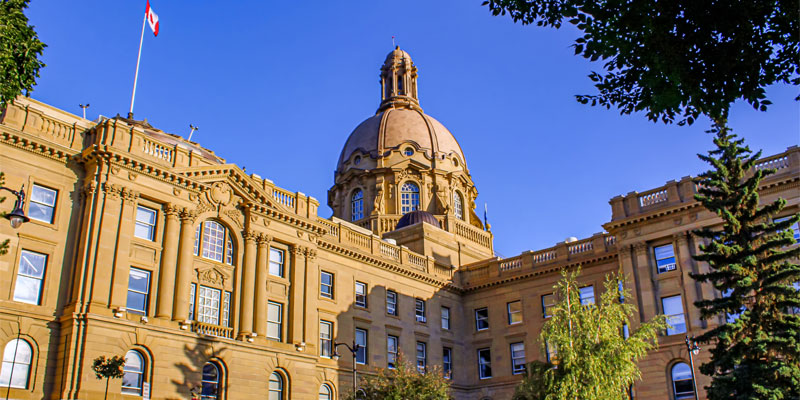Economic freedom key to recovery in Alberta

Alberta has a long way to go before it can regain the fabled “Alberta Advantage,” a powerful magnet that drew investment and migrants from across Canada and around the world. Perhaps nothing demonstrates this better than the province’s precipitous fall in economic freedom.
The Fraser Institute’s latest Economic Freedom of North America (EFNA) report includes a measure of the restrictions on economic freedom imposed by all levels of government and a second measure focused solely on provincial and municipal-level restrictions.
In the all-government measure, Alberta’s seven-year reign as the economically freest province or state in Canada, the United States and Mexico ended in 2015 and is in free fall. Alberta dropped to 6th in 2016, 23rd in 2017 and 33rd in both 2018 and 2019, the most recent year of available comprehensive data.
Economic freedom—the ability of individuals, families and entrepreneurs to make their own economic decisions—powers economic growth and prosperity by unleashing the drive and ingenuity of individuals and families. An immense body of research in top-peer reviewed journals shows that economically free jurisdictions grow faster, create more jobs and reduce poverty at much higher rates than less-economically free jurisdictions.
Alberta’s stellar economic performance until recent years was not only driven by oil and gas but also a high level of economic freedom, which encouraged entrepreneurship and investment in multiple industries. The Alberta advantage featured low taxes and relatively low government spending, coupled with sensible regulation, leaving Albertans freer to spend their own money and make their own economic choices.
Economic freedom requires a strong rule of law to guard the freedom of all, openness to trade, sensible regulation and reasonably-sized government. Changes in the latter two areas have hobbled Alberta’s economy. Due in part to developments largely outside the province, regulatory uncertainty and reversals have severely damaged Alberta’s energy industry.
Indeed, Ottawa increased taxes and introduced new ones (including the carbon tax), raised regulatory environmental restrictions and limited market access for Alberta oil by barring oil shipments on tankers over 12,500 metric tonnes through northern British Columbia ports.
While the full effect of these changes was not felt in 2019 (many were implemented part way through the year), there’s more to come, with more federal tax increases and regulatory barriers including a hard cap on greenhouse gas emissions in the oil and gas sector (while all other sectors are exempt).
But Alberta also has an entirely homegrown problem—the escalating size of the provincial government. This reduces room for free exchange and the dynamism of the private sector, which funds government. Among other measures, the EFNA report measures the impact of provincial and municipal governments—here, Alberta recorded the largest decline of any province between 2015 and 2019, as it did in the all-government index.
Alberta’s provincial spending grew from $27.2 billion in fiscal year 2005-06 with a budget surplus of $8.9 billion, to $40.3 billion in 2008-09 with a deficit of $0.9 billion. Then the global financial crisis hit, so spending went up. The problem is it never effectively came down.
By 2018-2019, spending rose to $56.4 billion. Revenues grew too but not nearly as much, from $35.9 billion in 2005-06 to $49.6 billion in 2018-2019, leading to a 2018-19 budget deficit of $6.7 billion. Followed by expenditures of $58.4 billion with a deficit of $12.2 billion (2019-20) and $60.1 billion with a deficit of $17 billion (2020-21). Of course, government spending skyrocketed with COVID. The current government pledges to control spending and restore tax competitiveness, which would boost Alberta’s economic freedom. But things aren’t looking immediately better.
The Alberta government predicts a budget deficit of $7.8 billion this fiscal year with net financial debt exploding to $69.8 billion. On the taxation side, Albertans have endured years of increases in the corporate tax, income tax, capital gains tax and taxes on fuel, health care, insurance and liquor among others (though the corporate tax increases were recently reversed with the general rate reduced to eight per cent, the lowest in the country).
Again, economic freedom is limited by taxation and government spending, even if paid for by pennies from heaven. The taxation side is clear but large expenditures increase government’s economic footprint and politicize the economy. The Kenney government faces unusual challenges with COVID, regulatory roadblocks and uncertain (albeit rising) oil prices, which underscore the need for provincial policies promoting economic freedom.
While the times and the challenges were different, both Prime Minister Jean Chrétien in the mid-1990s and Alberta Premier Ralph Klein in the early-1990s introduced large spending cuts while restructuring spending and taxation to reduce barriers to economic freedom.
Alberta and Canada were not weakened by spending cuts but strengthened by tax reductions and market-friendly policies. Economic growth was robust and fiscal restraint positioned Alberta and Canada well for the following decades.
The challenge for Alberta will be to re-establish fiscal balance and restrain the size of government to increase economic freedom and regain the “Alberta advantage.”


